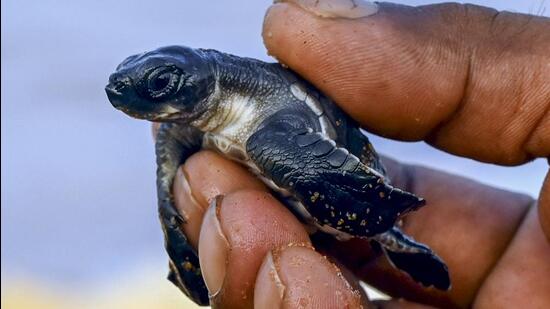A long study of Olive Ridley sea turtles, lasting 16 years, has discovered something amazing: the turtles nesting in Odisha, India, are very unique compared to others around the world and are older than those found in South America. These Olive Ridley turtles are the smallest of the sea turtles and usually lay their eggs at Rushikulya and Gahirmatha beaches in Odisha. Rushikulya is one of the biggest places in the world for turtle nesting, alongside beaches in Mexico and Costa Rica.
Just last month, a record-breaking 1.3 million Olive Ridley turtles laid their eggs at these beaches in Odisha, beating the old record of 1.15 million from 2023. Between March 20 and March 27, around 200,000 turtles returned to Rushikulya to nest.
The study, called “Monitoring Sea Turtles in India 2008-2024,” was done by the Wildlife Institute of India (WII), based in Dehradun, and the Centre for Cellular and Molecular Biology (CCMB). It was published by the Indian Institute of Science and Dakhin Foundation in Bengaluru. Scientists looked at the genetics of sea turtles along India’s coast and nearby islands. They found that the turtles in the Indian Ocean, especially on India’s eastern coast, are the oldest populations of Olive Ridleys. In contrast, the turtles in the Atlantic and Pacific oceans separated from the Indian Ocean turtles only about 300,000 to 400,000 years ago.
Earlier, people thought that about 3 million years ago, when the Panama Isthmus appeared, it separated the Olive Ridley turtles into two groups: one in the Atlantic and one in the Pacific. They believed that the oldest Olive Ridley turtles should be found in Central America. However, this new study shows that the first Olive Ridley turtles actually survived in the Indian Ocean and were only found in the Atlantic and Pacific later on.
The study also mentioned that as global temperatures rise, sea turtle populations could become more female. For example, over the past 15 years, researchers monitored the temperatures of turtle nests and the ratio of baby turtles by gender at Rushikulya, India’s largest nesting site. They found that around 71% of the hatchlings in Rushikulya were female on average. Some years had even more female hatchlings because of higher temperatures.
Shanker, a scientist at the Indian Institute of Science and Dakhin Foundation, said they are still trying to understand why mass nesting, called arribada, doesn’t happen every year. “We need more data over 15 to 20 years to find a pattern,” he explained. It’s still a mystery why these turtles all come together to nest and what stops them in certain years.





Leave a Reply